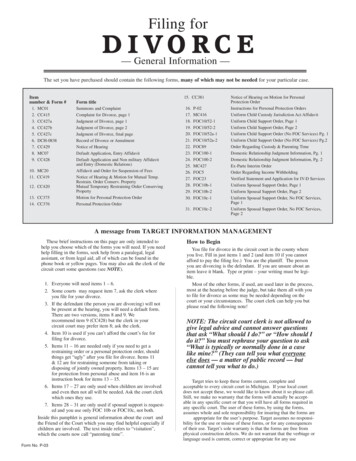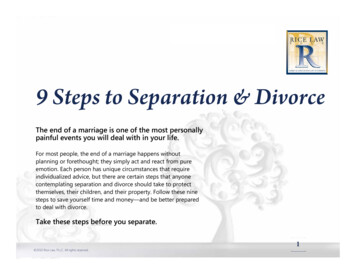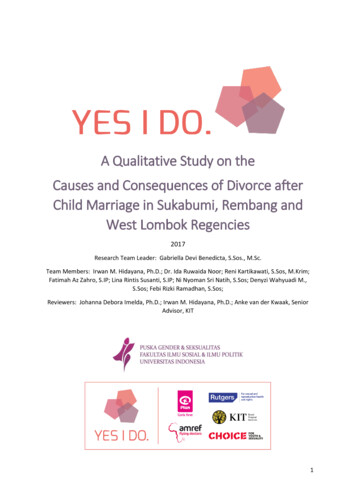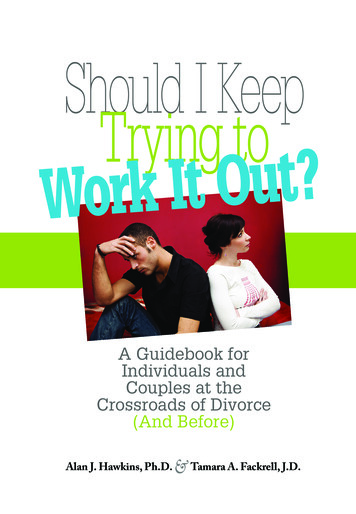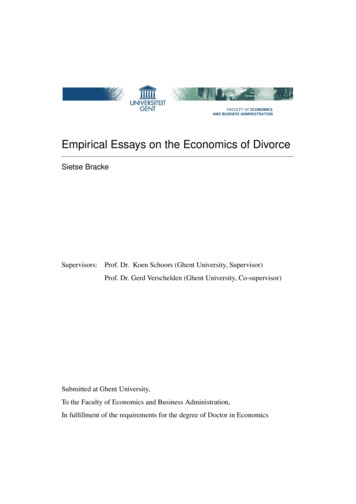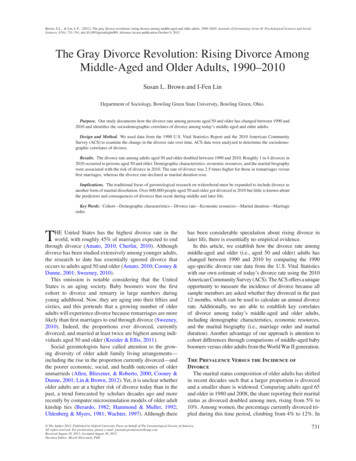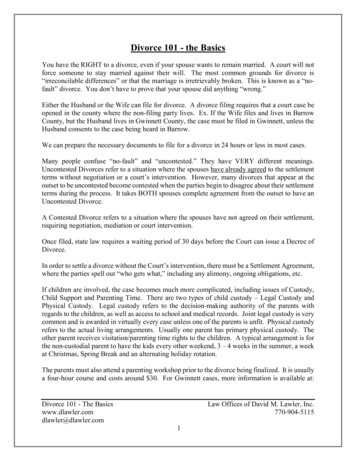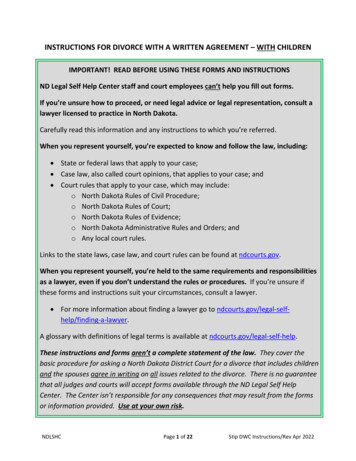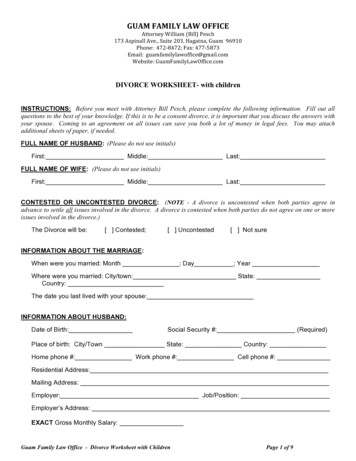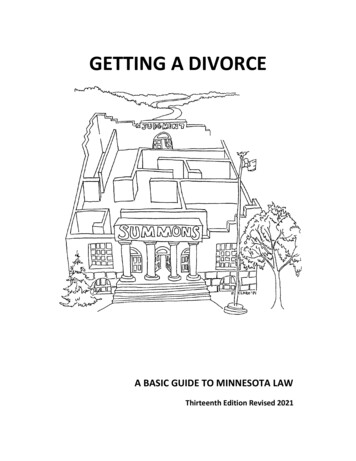
Transcription
GETTING A DIVORCEA BASIC GUIDE TO MINNESOTA LAWThirteenth Edition Revised 2021
PrefaceThis booklet explains your rights in a Minnesota divorce and includes information on custody,parenting time, child support, spousal maintenance, division of property and division of debt. Itis a guide and is not meant to answer all questions. This booklet only gives general rules, whichmay or may not apply to your situation.If you have a low income you can get a free copy of this booklet from your local Legal Servicesoffice. You can also find it online at www.LawHelpMN.org to view or print out.Others can purchase the booklet for 7.48 (which includes applicable sales tax, postage, andhandling) by going to www.mnlegalservices.org/orderbooklets.Questions on booklet ordering can be directed to Legal Services State Support at 651-228-9105,extension 6911.For free information about this and other civil legal topics, visit www.LawHelpMN.org.You can also find fact sheets on different legal subjects online at the website listed above orfrom the Education for Justice Program of the Minnesota Legal Services Coalition. Please call(651) 842-6915 for a list. 2021 Minnesota Legal Services Coalition. This document may be reproduced and used fornon-commercial personal and educational purposes only. All other rights reserved. This noticemust remain on all copies. Reproduction, distribution, and use for commercial purposes isstrictly prohibited.i
Table of ContentsChapter 1: Divorce Basics . 1Definitions. 1What are my rights before the divorce? . 2What are my rights if I am being abused, hurt or threatened? . 3What are the grounds for divorce? . 3Who can ask for a divorce? . 4How much will a divorce cost? . 4How long will a divorce take? . 4Who can help me with a divorce? . 4Can I represent myself? . 5Chapter 2: What Issues Does the Court Decide in a Divorce? . 6Issues in a Divorce Case . 6Custody . 6Parenting Time. 9Child Support . 12Spousal Maintenance (Alimony). 14Dividing Property . 15Dividing Debts . 16Insurance Coverage . 17Chapter 3: The Steps in a Divorce Case . 18What are the steps in a divorce? . 18What if we agree on all issues of the divorce? . 19Summons and Petition . 19Answer and Counter-Petition . 20Default . 20Initial Case Management Conference (ICMC) . 21Alternative Dispute Resolution. 21Parent Education Program . 23Temporary Relief Hearing . 23Guardian ad Litem . 24Custody Evaluation . 25Stipulation. 25Discovery . 25Pre-Trial Conference . 26Parenting / Financial Disclosure Statement . 26The Trial . 27Chapter 4: After the Divorce . 29What if I disagree with the decision? . 29Can I change the Judgment and Decree? . 29Changing Custody . 30Changing Child Support . 31ii
What if my ex-spouse is not following the Judgment and Decree? . 31What if I have problems with parenting time? . 33What if one of the parents wants to move out of state? . 33Kidnapping . 34How do I transfer property? . 35Legal Services Offices in Minnesota Listed by County . 37iii
Chapter 1: Divorce BasicsDefinitionsDissolution of MarriageIn Minnesota the process to divorce is called a dissolution of marriage. The court "dissolves" orends the marriage when the final papers are entered in the court's records. The final papersare called the Judgment and Decree. The Judgment and Decree contains the court's finaldecision on all issues of the divorce case. These include custody, parenting time, child support,spousal maintenance, and division of property and debt. Divorce cases are decided in familycourt.This booklet uses “divorce” to talk about the dissolution of marriage process.Legal SeparationMany people think that when a couple wants to live apart they have to get a "legal separation."This is not true. Often couples live apart for a while before they decide to get a divorce.Legal separations are for people who do not want a divorce (usually for religious reasons). Butthey need a way to settle custody, support, and property questions when they are not livingtogether. The court makes the same kinds of decisions that it makes in a divorce. But, thecouple remains married and the division of property is not final.A legal separation is similar to a divorce. It takes as long as a divorce. If the court grants a legalseparation and the husband or wife decide later to get a divorce, a new case must be started.You do not need to have a legal separation before you start a divorce.AnnulmentA legal annulment is a decision by the court that the couple was nevermarried. Some marriages are against the law, such as marriagebetween close relatives. Annulments are not needed in thosesituations because, under the law, there is no marriage. Marriages canbe annulled when: one of the people could not consent to the marriagebecause of mental ability or the influence of alcohol/drugs one of the people was too young to marry the couple never had sexual intercourseThe steps for getting an annulment are similar to the steps for getting a divorce. Talk to alawyer if you think you need an annulment.1
A legal annulment is not the same as a religious annulment. A religious annulment is grantedby a church and has no effect on legal marriages.What are my rights before the divorce?Both spouses have the same rights. Your legal rights are the same whether you are living withyour spouse or living apart.If there are children of the marriage, each spouse has equal right to decide: where the children live where the children go to school whether the children should see a doctorIf there is no threat of harm, you should think about the children’s best interests. It is importantfor children to maintain relationships with both parents.If you are worried your spouse will harm or not return thechildren, you do not have to let them go. But you do need a courtorder to keep them in your home.Each spouse has the right to use or get rid of any property thecouple owns. For example, either person can withdraw moneyfrom a joint bank account or charge on a joint credit card. Eitherspouse can use a car that is in both of their names. There aresome exceptions to this general rule. Neither spouse has the rightto cash checks made out to the other spouse. Neither spouse canwithdraw money from a bank account if it is in the name of the other spouse only. Neitherspouse can sell a vehicle that is in the name of the other spouse. Neither can sell real estatethat is in both names or in the name of one spouse.A spouse does not have the right to get rid of any property or money in anticipation of divorce.For example, if a spouse cashes out their retirement accounts because they don’t want theother spouse to get it, the court can still make the spouses share the money from that account.In most cases, the family court judge can require a spouse to share responsibility for the debtsof the other spouse, even if he or she did not know about or agree to the debts.2
What are my rights if I am being abused, hurt or threatened?No one has the right to hurt or threaten you or your child— not even your spouse.If you are being threatened, hurt, or abused right now,call 9-1-1.Get free, confidential help from Minnesota Day One CrisisHotlineat 1-866-223-1111 or www.dayoneservices.org.You may be able to get an Order for Protection (OFP). AnOrder for Protection (OFP) is a court order to stophousehold or family violence (domestic abuse). It ordersthe abuser not to hurt you. It can also: make the abuser leave your home keep the abuser away from you order temporary custody or parenting time (visitation) order temporary child support or spousal maintenanceIt doesn't matter whether or not you've started a divorce or if you're still living together.For information about how you can get an Order for Protection see our fact sheet “Orders forProtection and Harassment Orders” at ction-and-harrassment-orders.What are the grounds for divorce?Minnesota has a "no-fault" divorce law. You do not need to prove a spouse did somethingwrong to get a divorce. You just need to say that there is an “irretrievable breakdown of themarriage”. This means that there is no hope that you and your spouse will want to livetogether again as spouses.Because this is a “no-fault” state, a spouse who wants a divorce will be granted one even if theother spouse does not want a divorce.It also means that when the court is deciding issues, it cannot consider whose fault it was thatthe marriage broke down. For example, when the court decides how to split up the couple’smoney or who gets custody of the children, the court won’t base its decision on whether aspouse cheated on the other spouse.3
Who can ask for a divorce?You must live in Minnesota for at least 180 days (6 months) before you can start a divorce.Members of the United States Armed Forces can start a divorce in Minnesota if they have kepttheir Minnesota residence.How much will a divorce cost?There are court fees to get divorced. You have to pay a filing fee ofabout 400 to start or respond to a divorce case. There can beother fees if you participate in mediation, have a custodyevaluation, or if a guardian ad litem is appointed. These feeschange by county. Talk to the filing counter at your countycourthouse for more information on court fees.If you are low income and can’t afford to pay the fees, ask the courtfor a fee waiver. This is called “In Forma Pauperis” or IFP. This formasks the court to lower the fee or waive it so you don't have to pay.You can download the forms to fill out on the court’s website athttps://www.mncourts.gov/GetForms.aspx?c 19. You can also fill out and file your fee waiverforms online using the court’s Guide and File interview. To start the Guide and File interview: Go to https://minnesota.tylerhost.net/SRL/SRL Click “Request for Fee Waiver”How long will a divorce take?The length of time to complete a divorce depends upon several things. If both sides reach anagreement or if one spouse never responds to divorce papers, a divorce can be finalized in a fewmonths. If spouses can't agree, then the judge has to decide. In this case it will take much longerbecause the court will need to gather information and schedule hearings in order to make a fairdecision. If the parties disagree, the divorce can sometimes take 6 months to 2 years.Who can help me with a divorce?There is no right to a free lawyer in a divorce case. There are non-profit law firms that providefree legal help for those with low incomes. A list of the legal aid offices in Minnesota is at theend of the booklet. You can also check https://www.lawhelpmn.org/providers-and-clinics tosee if you qualify for a free lawyer.If free legal help is not available, or you do not qualify you will need to hire a private lawyer orrepresent yourself. If you hire a private lawyer you have to pay their fees. Attorney fees canvary a lot. If the case is easy and the spouses can agree on how to resolve the issues, it might bea few hundred dollars. If the case is difficult and there are hard custody and/or property issues,it might be thousands of dollars.4
It is important that you understand the fees your lawyer charges before you hire them.Lawyers charge an hourly fee for their services. You are charged each time the attorney workson your case. Ask your attorney for a written “Retainer Agreement” or letter which explainshow you will be charged for their services.If you can afford a lawyer, but don't know any, you can contact the Minnesota Lawyer Referraland Information Service at https://mnlawyerreferral.org/public-area, or by calling (612) 7526699. The Lawyer Referral Service can give you the name and telephone number of a privatelawyer in your area who may be able to represent you. When you call to make an appointment,ask the lawyer if the first appointment (called a consultation) is free. You may have to pay aninitial fee for the first appointment with the lawyer.Can I represent myself?Yes. Many people represent themselves in divorce cases. If you represent yourself, you maybe called a “pro se litigant” or “self-represented litigant.” You can get all the forms you need tostart or respond to a divorce case on the court’s website.Using the “Guide and File” InterviewYou can fill out and file your divorce forms online using the court’s Guide and Fileinterview. This program helps you create the forms to ask the court for a divorce. It works byasking you questions. It uses your answers to fill out the forms. You can file your forms withthe court electronically. Or you can print your forms and take them in person to thecourthouse to file.To start the Guide and File interview: Go to https://minnesota.tylerhost.net/SRL/SRL Click “Starting a Divorce in MN”Downloading the FormsIf you don’t want to use the Guide and File program, you can find theforms to download and fill out at http://www.mncourts.gov/Help-Topics/Divorce.aspx. At thatwebsite, click the “Forms” tab to see the different forms available for download.Getting help at the Self-Help CenterThere are Self-Help Centers that can answer questions about how to fill out these forms oranswer questions about the divorce process. Call the Statewide Self-Help Center (651) 4356535. Or find a Self-Help Center in your area http://www.mncourts.gov/selfhelp/ or call (651)435-6535.5
Chapter 2: What Issues Does the Court Decide in a Divorce?Issues in a Divorce CaseThese are all the issues that need to be decided in a divorce. If the parties cannot reachagreements on these issues, the court decides. If the couple does not have children, the firstthree issues do not apply to them.1. Custody2. Parenting Time3. Child Support and Dependent Tax Exemptions/Child Tax Credits4. Spousal Maintenance5. Division of Property6. Division of Debt7. Insurance CoverageCourts in Minnesota usually only have power over people and things in Minnesota. This poweris called jurisdiction. If a spouse is served with divorce papers outside Minnesota or could notbe found and was served by publication, the court is limited in what it can decide. The courtmay only be able to: dissolve (end) the marriage decide custody and parenting time for children living in Minnesota award ownership of property located in MinnesotaWhen a spouse is served in another state, a separate childsupport proceeding can be started with the help of the countychild support office and the county attorney. In this proceeding,the Minnesota court tells the court in the other state that a parentwho lives in the other state owes child support. See ourbooklet “Child Support Basics” for more rt-basics.CustodyThere are 2 parts to custody: Legal Custody Physical Custody6
Legal CustodyLegal custody could be called “decision-making custody.” This custody involves the right of aparent to make major decisions about the child’s life, such as: where the child attends school religion major health careThe court can give legal custody to one parent or to both parents together. This is called jointlegal custody. Joint legal custody means both parents have equal rights and duties in makingmajor decisions. They need to agree when major decisions need to be made. The court prefersthat parents have joint legal custody, unless the parties cannot work together to makedecisions or there has been domestic abuse. Sole legal custody means one parent makes themajor decisions.Whether legal custody is sole or joint, both parents have the right to be informed about thechild’s schooling, health care, and other major decisions. Both parents can attend schoolconferences, attend medical appointments, and have reasonable telephone or electroniccontact with the child (for example, video calls).Physical CustodyPhysical custody means living with the child and making day-to-daydecisions about the child’s care. Sole physical custody means that thechild lives primarily (mainly) with one parent. Joint physical custodymeans the child lives with both parents and shares time between theparents. Joint physical custody does not mean the parents will haveequal time with the child. The schedule doesn’t have to be equal forphysical custody to be joint. Parenting time is what controls how much time the child spendswith each parent.How does the court decide custody if the parents don’t agree?If the parties don’t agree on custody, the court must decide. The court looks at the following 12factors to decide what is in the best interests of the child. The 12 factors are:1. The child’s physical, emotional, cultural, spiritual, and other needs. How does theparents’ plans for the child affect these needs and the child’s development?2. Does the child have any special medical, mental health, or educational issues that needspecial parenting arrangements or access to services?3. What does the child want? The child’s wishes may influence the court if the courtdecides the child is able, old enough, and mature enough to make a choice.7
Note: Your child won’t be able to testify at the trial. Be very careful how you talk aboutthe court case with your child. It is very damaging for kids to get caught in the middle oftheir parents’ fights. In some cases, a professional chosen by the court meets with yourchild to talk to them about their wishes.4. Has domestic abuse happened in either parents’ household or relationships? What arethe details of what happened, and does it affect parenting or the child’s safety orneeds?5. Does a parent have physical, mental, or chemical health issues that affect the child’ssafety or developmental needs?6. How has each parent provided care for the child in the past?7. The willingness and ability of each parent to keep caring for the child. How does eachparent meet the child’s developmental, emotional, spiritual, and cultural needs? Canthe parent be consistent and follow through with parenting time?8. Will changes to home, school, and the community affect the child’s well-being anddevelopment?9. The relationships of the child with each parent, siblings, and anyone else who isimportant to the child. Do the proposed custody plans affect these relationships?10. It is usually better for the child to spend as much time as possible with both parents.The court looks at this and looks at if spending less time with one parent might harm thechild in some way.11. Will each parent help the child have contact often and regularly with the other parent?(except when there is family violence – see #4)12. The willingness and ability of parents to cooperate in raising their child. Can the parentsshare information? Can they keep the child away from their conflicts? Do they havegood ways to resolve arguments over big decisions about the child?The court must write findings (reasons why they are deciding a certain way) on all of thesefactors. The court must say how it decided what is in the best interests of the child. The courtmust look at all the factors to make their decision, not just one.In some cases, the court cannot make a decision about custody because the children do not livein Minnesota or have not lived in Minnesota long enough. In these cases the court has no legalauthority to decide custody.8
It is difficult for a parent convicted of certain crimes of violence or abuse to get custody orparenting time. A special person called a “guardian ad litem” will be appointed to look for thebest interests of the children and to make recommendations to the judge.Parenting TimeWhen parents are separated, the court usually wants bothparents to be involved with their child. Parenting time is the timethat each parent spends with a child. It does not matter who hascustody or what kind of custody. Parenting time is the same asvisitation.Parenting time can be set by the court. If the child lives primarily(mainly) with one parent, the other parent (also called the “noncustodial parent”) can be awarded parenting time. The court canalso set a parenting time schedule when parents have jointcustody. Parenting time must be in the child’s best interest.To set parenting time, the court looks at factors such as the child’s age, the child’s safety, andthe child’s past relationship with the non-custodial parent. There are 12 best interest factorsthe Court must consider. See the “Custody” section starting on page 6.In general, a non-custodial parent gets at least 25% of the parenting time. This is calculated bycounting the number of overnights in a 2-week period. For example, 25% equals about everyother weekend and one overnight a week. The court may calculate parenting time based on amethod other than overnights if the child spends significant time with the parent but does notstay overnight.Denying or interfering with a set parenting time schedule can cause more time being awardedby the court to the parent who was denied their regular parenting time. The court will look atthe reasons why the parenting time schedule was not followed. If the court determines that aparent purposefully denies or interferes with parenting time more than once, the court willaward more parenting time to the parent who was denied their regular parenting time. Theonly exception is if the denial of parenting time was to protect the child’s physical oremotional health. The court could also give a penalty to the parent who denied or interferedwith the other parent’s regular time or consider it a factor when deciding a change of custodymotion.Scheduled Parenting TimeIf the parents cannot agree on a schedule, the court will set aparenting time schedule. The court will consider the age of thechild, how far apart the parents live, school schedule, and afterschool activities when setting a parenting time schedule.9
Parents can always agree to change parenting time. For example, either parent can ask theother parent to skip a day or make it up another time. But if the parents don’t agree on thechanges, they must follow the parenting time schedule in the court order.Additional Parenting Time to Provide Child CareThe court may give more parenting time to one parent to care for the child while the otherparent works. This kind of plan has to be fair and in the best interest of the child. If you ask forthis, the court looks at:1. How well the parents cooperate2. How well the parents work together on parenting time issues3. If there has been domestic abuse between the parentsCourts cannot lower child support payments because they order this kind of childcare.Parenting Time ExpeditorThe court may appoint a parenting time “expeditor." This is someone who helps parents whenthey have a disagreement about parenting time. The expeditor listens to both sides of adisagreement and tries to help the parties resolve the disagreement. If the parents continue todisagree, the expeditor makes a decision.The expeditor’s decision is “binding” (has to be followed) unless one side goes to court and thecourt changes it.The court can’t require parents to use a parenting time expeditor if (1) either parent claims tobe a victim of abuse OR (2) the court decides that a parent may have physically harmed orthreatened the other parent or the child(ren).The parents have to pay for a parenting time expeditor. The court will decide how much eachparent pays before appointing the expeditor. If a parent cannot afford to pay the expeditor’sfees, the court can’t require parents to use a parenting time expeditor. Expeditors may not beavailable in all counties.Restricted/Supervised Parenting TimeThe court can limit parenting time to less than 25% if it is likely to harmthe child’s physical or emotional health. The court can also limitparenting time if a parent breaks the court’s order on parenting timewithout a good reason.The court may restrict parenting time by: limiting the hours of parenting time or not allowingovernights10
limiting the place where parenting time can happen requiring the parent only visit when another person is present (supervisedparenting time) denying parenting timeThe court can also put conditions on parenting time, like making the non-custodial parent besober for a certain period before and during parenting time. The court can order drug or alcoholtreatment.If a parent asking for parenting time has been convicted of certain crimes, that parent mustprove that parenting time with the child is in the child's best interest. These crimes include: murder, manslaughter assault kidnapping depriving someone else of custodial or parental rights soliciting, inducing or promoting prostitution involving a minor criminal sexual conduct incest malicious punishment of a child neglect terroristic threats felony harassment domestic assault by strangulationThis rule applies only to certain degrees of some crimes and only in certain circumstances, like ifthe victim of the crime was a household or family member or if the conviction happened in thepast 5 years.Voluntary Parenting PlansParents can agree to use a “Parenting Plan.” They work on writing a plan that states the timeeach parent spends with the child and how they are going to make decisions about the child.The court must approve this plan and it must be in the best interest of a child. See the 12 BestInterest Factors in the “Custody” section on page 7.The Parenting Plan must have: A schedule of the time each parent spends with the child AND11 p
This booklet explains your rights in a Minnesota divorce and includes information on custody, parenting time, child support, spousal maintenance, division of property and division of debt. . Order for Protection (OFP) is a court order to stop household or family violence (domestic abuse). It orders the abuser not to hurt you. It can also:
